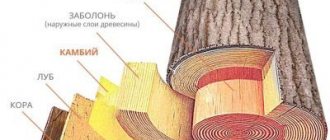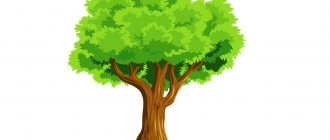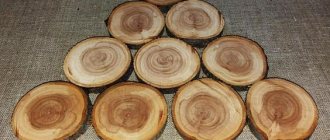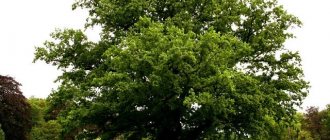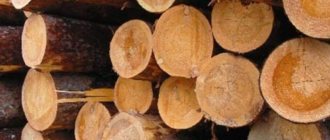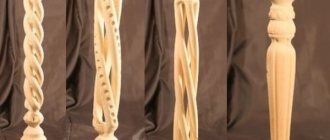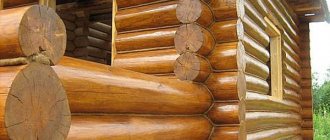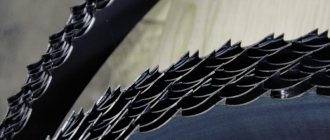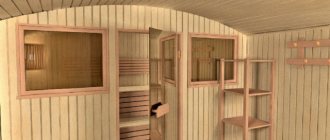Macroscopic structure of wood
Macroscopic structure of wood
The macroscopic structure of wood allows us to study the structure at the macrostructure level - visible to the naked eye without the use of magnifying devices or a microscope. All branches that appear on a tree always remain at the same height. The tree grows in height due to the appearance of new shoots every year. The increase in the diameter of the tree occurs due to the cambium - a layer of wood located directly under the bark and differs from other layers in its softness. The cambium is a growth tissue that allows growth both inward and outward of the tree. The outer cells form a bast, the outer layers of which, as the diameter of the trunk increases, die off and become the bark. The inner cells allow the layers of wood to grow. The wood also gradually dies, forming a central solid base, and the living part of the wood, the sapwood, provides further growth.
Sapwood and heartwood
When studying the structure of wood macroscopically, we observe that some tree varieties have a uniform color throughout the entire cut, while others have lighter layers of wood around the dark-colored central part. The central part is called the core, and the layers surrounding it are called sapwood. There are tree species in which the central part of the trunk does not differ from the outer part in color, but contains less water (we are talking about a living tree). Such wood is called mature wood, and the general name for wood species with mature wood is mature wood species. Rocks with a pronounced core are called core rocks. In addition, there are rocks whose water content in the central and peripheral parts is the same, as is the color. Such types of wood are usually called sapwood.
In fact, every type of tree has a core, but not all have a dark color. In fact, mature wood is the core of the tree and differs only in color. And trees of this type are called coreless.
Within the group of coreless species, mature wood and sapwood varieties are distinguished. In the first, the peripheral part of the tree has higher moisture content than the central part, and in the second type of rock, the tree moisture content is the same across the cross section of the trunk. Deciduous tree species are classified as sapwood trees. The upper part of the tree contains a larger volume of sapwood. Closer to the butt part, its volume decreases. The volume of sapwood also depends on the age of the tree; with increasing age, its volume decreases. Sometimes the central part of the trunk of non-core tree species darkens. In such cases it is called a false nucleus.
Young trees do not have a core. It forms over time, in different breeds at different times. So, in pine when it reaches 30-35 years of age, and in oak - in the period between 8 and 12 years. Therefore, the width of sapwood in oak is smaller than in pine. As the diameter of the trunk increases, some of the sapwood passes into the core. Let's look at the example of oak. If a young tree has a trunk diameter of 15 cm, then the volume of the heartwood and sapwood is approximately the same. When the trunk diameter reaches 30 cm, the volume of the kernel becomes approximately 3-5 times greater than the volume of the sapwood. When the diameter is 60 cm, then 90% of the volume falls on the core of the tree.
The size of the sapwood is directly affected by the conditions in which the tree grows. Oaks growing on solonetz soils have wider sapwood than oaks growing in floodplain oak forests. At the same time, the width of oak sapwood remains the same throughout the entire height of the trunk, while in pine and spruce the amount of sapwood increases in the upper part of the trunk. With age, the width of sapwood in pines increases. After reaching a hundred years of age, the annual growth of wood decreases, and accordingly, the width of the sapwood decreases.
The sapwood in a growing tree serves as a “plumbing pipe” - water rises through it to the upper part of the trunk. In addition, it accumulates nutrients necessary for growth.
The core is formed due to the death of living wood cells, clogging of water-conducting channels, the formation of resins and calcium carbonate. The wood of the core zone itself is impregnated with tannins and dyes and acquires increased density. In light of all these phenomena, it acquires increased resistance to putrefactive microbes.
The wood of the core part is very dense, due to which it is often used for making containers for liquids. The core part, due to its high density, is poorly saturated with antiseptics, which is necessary to know when using wood in industry.
Tree rings (growth layers)
Seasonal growth of a tree produces a new layer of wood, which is called an annual ring. Concentric rings on cross sections of wood can tell you about the age of the tree. If you imagine the structure of the trunk as several cones placed on top of each other, then the number of rings on the cut (minus two) determines how many years it took the tree to grow to the height of this cut. The number of rings in the butt part indicates its general age. So, if in the lower part we see 12 rings, then the tree is currently 10 years old. And if in the upper part the cut is represented by 7 rings, this means that the tree grew to this height for 5 years.
The pattern formed by the annual rings depends on the nature of the cut. This can be seen more clearly in sections of coniferous trees. The radial cut will be represented by parallel longitudinal stripes, the transverse cut will look like concentric circles, and the tangential cut will have a pattern with winding stripes.
The width of the annual layers is influenced by the type of tree, its growing conditions, age and place of cutting. Slow-growing trees produce narrow annual layers, while fast-growing trees produce wide ones. A young tree forms wide annual layers, while an old tree forms narrow ones. Naturally, the annual layers on the main trunk are wider than on the branches. The better the conditions in which the tree grows, the greater the annual growth of wood and the width of the annual layer.
It is also interesting that if we consider a cross section of a tree, we can note the following pattern: the width of the annual layers at the core is small, it increases to a certain maximum, after which it decreases again.
Near the tree bark itself, the annual layers are small in width. Thus, by examining the structure of a tree, the width and number of annual layers, one can even imagine how the climate changed during the period of its growth. And with the help of simple calculations you can determine the time of manufacture of an object made of wood.
Trees growing in groups under the same conditions usually have an almost cylindrical trunk, with a slight taper at the top. A striking example of this is the ship pines, tall and slender as if by choice; they all have the same trunk thickness, almost from the base to the top. If you look at a pine tree growing alone in a field, its trunk usually has many branches and its crown is spreading. The girth of the base of such a pine is large, and at the top the trunk narrows sharply. Scientists call such a trunk runaway. In this case, there is often a difference in the width of the annual layers on opposite sides of the tree. There is a kind of displacement of the central part of the trunk. On lateral branches, the core is almost always offset from the center and the cut looks more like an ellipse than a circle.
Not all trees in cross section look like concentric circles. There are tree species with wavy annual layers. For example, these include alder and beech.
Annual layers grow from the center to the periphery. Often their inner part has a lighter color and less hardness than the outer part. This is especially noticeable in coniferous trees. Water with nutrients rises along the inner part of the annual layers (early wood), and the outer parts (late wood) give the tree strength.
Core rays
Each tree in section has pith rays - light lines that diverge from the core part of the tree to the bark. They are not always visible visually, but are always present. Their width is small - from 0.005 to 1 mm (very narrow, narrow or wide). Wide beams can actually consist of several narrow beams located next to each other.
A radial section of the tree shows such rays in the form of spots or shiny transverse stripes, which sometimes form a peculiar pattern. The more the direction of the beam coincides with the plane of the wood cut, the longer its visible pattern on the cut.
In a tangential section, the shape of the rays is similar in outline to a spindle or lentil fruit. Their cross-sectional height depends on the type of wood.
During the life of a tree, the medullary rays conduct water and nutrients along horizontal planes. In a growing tree, the pith rays serve primarily to conduct water and nutrients horizontally and to store reserve nutrients in winter.
Each type of tree has a different number of pith rays. If, on a tangential section of a birch or pine tree, we count their number in an area of 1 square centimeter, we will get a number equal to 3000 or more. And if you similarly count the number of rays in a juniper, then there will be approximately 15,000 of them. They are very narrow and resemble hair-like rays.
The lower part of the tree trunk has a very large number of rays; as you go up, their number decreases. True, in the crown area their number increases slightly. The parameters of the rays increase from the central part of the trunk to the peripheral, as well as their number. Within trees of the same species, these indicators depend on the conditions in which they grow. Deciduous tree species have a larger number of pith rays compared to coniferous trees. As a percentage of deciduous species, their share is 15% of the volume of wood, and 5-8% is the share of coniferous trees.
Core reps
On longitudinal sections of deciduous trees, you can observe dashes, spots or stripes along the boundaries of the annual layers. They are colored dark brown or brown, and their structure is identical to that of heartwood. For some species, the presence of such stripes and spots is a reliable diagnostic sign when it is necessary to determine the type of wood by looking at the wood. Such formations are observed in the lower part of the trunk. Coniferous trees are very rare.
Vessels are conductors of moisture and nutrients
In deciduous trees, water is drawn from the soil by the roots, and then, through special vessels that look like ordinary tubes, it is supplied to the rest of the tree. On a cross section of wood, the vessels look like small holes.
There are no vessels in the structure of coniferous trees.
The sizes of the vessels range from very small, which can only be seen with a microscope, to large ones visible to the human eye. At the same time, they are distributed mainly in the early region of the annual layers and form a ring when cut, sometimes evenly scattered over the entire area of the annual layer. Small vessels are more often found in groups, and in the absence of large ones they are evenly distributed over the area. Closer to the outer edge of the annual layer, their number and size decrease.
Based on the nature of the distribution of blood vessels, ring-vascular and scattered-vascular types are distinguished. In the first, the growth rings are clearly visible due to the difference between the early and late regions of the layer. In wood species that have a scattered vascular arrangement of all vessels, the growth rings have a uniform structure and the outer boundaries are difficult to distinguish.
On a radial section, groups of small vessels can form a pattern in the form of tongues of flame, on a tangential section - wavy solid or broken lines. With the scattered nature of the distribution of vessels, they are visible on the section in the form of individual light-colored dots. A typical example is ash wood.
Grooves of various sizes visible on a longitudinal section of wood are vessels. They are not necessarily located vertically, since they only partially fall within the cut area. The sizes of the vessels range from 0.016 to 0.4 mm and also depend on the conditions in which the tree grows. The vessels located close to the core increase in diameter as they move away from it, and then, having reached their maximum limits, they begin to decrease or remain constant. In the direction from the base of the tree to its top, the number of vessels and the cross-sectional area in the longitudinal section increases.
Due to the presence of vessels in deciduous wood, there is a high permeability of gases and liquids. Their presence reduces the strength of wood.
Resin passages
Coniferous trees (spruce, pine, cedar and larch) are distinguished by the presence of thin paths filled with resin - they are called resin passages. And yew, fir and juniper do not have resin passages.
Based on how the resin ducts are located in the tree trunk, they are divided into horizontal and vertical. Vertical ones, together with the core rays, create a resin-bearing system, which makes it possible to extract resin using the tapping method. On cross sections, vertical resin ducts look like whitish dots. They are observed in the area of the late zone in annual layers.
Due to the resin, wood is resistant to rotting processes.
Bark of tree
The bark performs the following physiological functions of a tree during its growth:
- carries nutrients produced by leaves along the trunk;
- protects the tree from external adverse conditions.
The bark of a tree has a complex structure and consists of the following complex of tissues in the form of layers:
- inner layer adjacent to the cambium (bast);
- outer layer (crust).
Each layer zone has a specific structure and chemical composition, each zone has its own biological functions. The transition from one layer to another can be sharp or smooth depending on the type of wood.
The ratio of the zones of these layers is different for different species and even for trees of the same species growing in different places. The proportion of crust in the bark ranges from 20 to 80%.
The larger the diameter of the tree trunk, the thicker the bark on its surface (Table 1). But with increasing age of the tree, and therefore its diameter, the relative volume of the bark decreases, since the larger the diameter of the trunk, the smaller the proportion of bark in the volume of the trunk [2].
Table 1. Dependence of bark thickness on trunk diameter [2]
| Breed | Measurement location* | Bark thickness, mm, with log diameter, cm | |||||
| 12 | 20 | 28 | 36 | 44 | 48 | ||
| Pine | K S | 2,0 1,8 | 2,8 2,2 | 5,0 3,0 | 12,0 5,0 | 16,0 6,5 | 20,0 — |
| Spruce | K S | 3,0 3,0 | 4,0 3,8 | 4,5 7,5 | 6,0 5,5 | 9,0 7,0 | 10,0 — |
| Birch | K S | 4,0 4,0 | 6,5 6,0 | 7,5 7,5 | 11,0 11,0 | 14,0 — | 16,0 — |
| Aspen | K S | — 4,2 | — 7,0 | 10,0 25,0 | 12,0 12,0 | 14,0 14,0 | 15,0 15,0 |
| Larch | K S | 17,0 12,0 | 20,0 14,0 | 25,0 16,0 | 27,0 18,0 | 30,0 20,0 | 31,0 22,0 |
| * K – butt of the tree at a height of approximately 1.5 m; C – middle of the trunk. | |||||||
The thickness of the bark decreases from the butt to the top of the trunk, and the relative volume of the bark changes accordingly along the height of the trunk.
Within one species, the worse the growing conditions of the tree, the greater the relative volume of bark. Indicators of bark volumes of different rocks vary significantly (Table 2) [2].
Table 2. Bark content in the volume of the tree trunk
| Breed | Pine | Spruce | Birch | Aspen | Larch |
| Bark volume relative to trunk volume, % | 10−12 | 7−10 | 13−15 | 14−15 | 18−25 |
The bark has a complex structure, which includes the boundary layer between wood and bark - the cambium, the inner and outer layers of the bark, as well as physiological boundary zones.
2.1. Cambium
At the boundary between the inner bark layer and the wood there is a boundary layer called the cambium layer or cambium. In a tree trunk, the cambium consists of living wood cells. Due to the fact that these cells continuously divide, wood and bast tissues grow. As a result of such vital activity, the diameter of the tree trunk and the thickness of the bark layer increase. In the structure of the trunk, in comparison with the cells of other parts of the tree, the cambial layer has the lowest mechanical strength, which is what the principle of debarking timber is based on.
2.2. Inner layer of bark (bast or phloem)
In the zone from the cambium to the crust there is a bast layer. On the inside, it passes into the cambial zone, which forms the cells of bast and wood, and on the outside, into the cork cambium.
Bast fabrics are divided into three types:
- sieve tubes with cells;
- mechanical tissues (sclereids and fibers);
- bast parenchyma with parenchyma cells. Each type of fabric performs its own functions.
The bast ensures movement through the filter tubes of which it consists, along the tree trunk, to all organs of nutrient organic substances (photosynthesis products) formed in the leaves. The fibrous structure of the bast is oriented along the tree trunk.
In some conifers, for example pine, the phloem cells on the inside differ little in structure from the cambium cells, and they are called cambiform. The presence of cambiform cells determines the gradual transition from cambium to phloem. The transition of the bast from the outside to the bark is sharper.
The difference in mechanical strength and the ratio of bonds of cambium cells with wood, cambiform with bast and bast with bark is used to determine the types of debarking with complete cleaning of the wood from the bast (clean debarking) or leaving this layer (rough debarking).
In the transition zone between the lumen of the rib cage there is a layer of parenchyma cells. When these cells divide, bast parenchyma cells are deposited on the inside, and cork cells are formed on the outside. The shells of the latter have no pores and are impregnated with suberin, which makes them impenetrable to water and air. The framework structure of the crust is formed by bast fibers and stony cells. In general, cork cells perform a protective function. In addition to the listed features, bast has a number of other properties.
Thus, in contrast to the cells of the crust, the cells of the bast tissues have an increased content of uranic acids and pentosans, suberin is absent, and the shells consist of cellulose and hemicellulose and do not contain lignin [1].
The bast contains more extractives, uranic acids and pentosans, but less lignin. It also contains 1.5 times less cellulose than wood [1].
The volumetric ratio of peel and bast changes along the trunk. In the butt part of the pine, where the integumentary tissue is significantly developed, the bark makes up the bulk of the bark volume. In spruce, the change in structure and volumetric ratio of rind and bast along the length of the trunk is insignificant.
2.3. Crust
In the technical literature, the crust can be called differently, for example, a layer of dead cells, a cork layer or a secondary cortex, periderm. In any case, these terms mean the outer dead layer of bark, which serves the function of protecting bast and wood tissues from mechanical damage, penetration of fungi and bacteria, sudden temperature fluctuations, moisture evaporation, and external climatic influences. Different types of wood have different rind structures and strengths. In conifers, it is loose and fragile, so during the debarking process it is easily destroyed by tools and removed from the surface of the trunk.
The bark of deciduous trees, aspen and especially birch has a greater strength of the cortical outer part and a significantly thicker bast layer. These factors complicate the debarking process. In addition, birch bark, or birch bark, has high strength in the longitudinal direction, and is torn and separated mainly only in the transverse direction. This makes debarking and shredding the bark even more difficult.
Bibliography:
- Simonov M.N. Mechanization of timber debarking. M.: Lesn. industry, 1984. 214 p.
- Simonov M.N., Torgovnikov G.I. Debarking machines. Design and operation. M.: Lesn. industry, 1990. 182 p.
888
Determination of wood species by macroscopic structure
The structure of each type of wood is closely related to its properties. Knowing the type of wood, you can fairly accurately assess the technological properties of wood and its physical and mechanical properties. Scientists have compiled these properties for each type of wood into a reference database, which serves as a guide in choosing the necessary materials for specific purposes.
You can determine the type of tree using wood characteristics such as:
- Presence or absence of a nucleus.
- The width of the sapwood layer and the nature of the boundary between it and the core part.
- Clarity of annual layers and their outlines on a cross section.
- Within the annual layers - the nature of the distribution of early and late wood and the clarity of the boundaries between them.
- The presence of medullary rays, their number, size and coloring.
- In deciduous trees, the distribution area, the size and number of vessels, their condition.
- In coniferous species - the number and size of resin ducts.
- The presence or absence of core repetitions.
Using additional wood characteristics, such as wood density and hardness, texture and shine, will make the species determination process much more accurate.
The color of wood is also used in diagnostics, although it is necessary to be very careful and take into account the degree of its change from external physical, chemical and temporary influences.
Drawings on longitudinal sections of wood provide good assistance in correct determination. The density and hardness of wood is very important when determining the type of hardwood, since quite often other characteristics are very poorly expressed.
Wood carving
Wood structure
Wood is an amazing material given to man by nature. It is indispensable in folk arts and crafts, in the production of various products for utilitarian and decorative purposes, organically included in the ensemble of modern life. Wood has high physical and mechanical properties, thanks to which it can be sharpened, planed, cut; beautiful texture, allowing it to be used for making art products and souvenirs. But at the same time, it is hygroscopic, as a result of which, depending on the humidity of the environment, it can swell or shrink, warp or crack; subject to destruction and rotting. Therefore, before you start working with wood, you need to become familiar with its properties, structure and defects.
A growing tree consists of the following parts: root, trunk, branches and leaves.
Roots
feed the tree and keep it upright.
Trunk
makes up the bulk of the tree, occupying up to 90% of its volume. This is the most valuable part and is a source of wood.
Branches
act as channels through which the exchange of substances occurs between the leaves and the rest of the tree.
Leaves
serve for respiration: they absorb carbon dioxide from the air and release oxygen. The shape of the leaves is narrow, needle-shaped, and wide. Trees with narrow leaves, or needles, are called coniferous, and those with wide leaves are called deciduous. Coniferous species include, in particular, pine, spruce, larch, cedar, yew, juniper; deciduous - birch, oak, beech, chestnut, maple, linden, alder, aspen, ash.
Depending on the species and growing conditions, the lifespan of a tree can be up to 300 years or more (oak, pine, linden, spruce). The older the tree, the thicker the trunk and the more valuable the wood.
The structure, appearance and properties of wood depend on the direction of the fibers relative to the axis of the trunk. In order to familiarize yourself in detail with the structure of the tree, it is necessary to make three main cuts: end, tangential and radial (Fig. 1). A cut perpendicular to the axis of the trunk is called transverse
or
end
, a cut running along the trunk through its core is
radial
, and a cut running along the trunk away from the core is
tangential.
Rice. 1.
Main trunk cuts
The cross-section (end) shows the main parts of the trunk: bark, wood and core.
Core
located in the center and is a loose tissue with a diameter of 2–5 mm. It most often looks like a small dark spot.
The cambium is located between the bark and wood.
- a thin layer of living cells, thanks to which the tree grows in thickness. In this case, wood growth occurs approximately 10 times faster than bark.
Wood
makes up up to 90% or more of the trunk volume. It consists of core and sapwood.
Core
adjacent to the core and represents a dead central zone that does not participate in physiological processes.
Sapwood
- living zone of wood.
Bark
consists of two layers: the outer - crust and the inner - bast layer. The photosynthetic products produced in the leaves travel through the bast layer to the roots. The outer layer serves to protect the wood from external influences.
At an early age, wood of all species consists only of sapwood. Over time, the living elements around the core die, the water supply pathways become clogged and extractive substances (resins, tannins, dyes) are deposited in them.
The wood of domestic forest species usually has light colors, while some of them have the entire cut of one tone, while others have a darker central part. The dark-colored part of the wood is the heartwood, and the light-colored part is the sapwood. Species that have a clear distinction between heartwood and sapwood are called heartwood
, for example: pine, oak, ash, apple, poplar, juniper, etc.
Breeds in which there is no clear difference are called coreless
.
Coreless species are divided into two groups: mature wood (spruce, beech, aspen, pear, linden, fir), the humidity of the central zone is less than the peripheral one, and sapwood, the humidity of which is the same across the cross section of the trunk. Sapwood includes deciduous trees - birch, maple, hornbeam, linden, boxwood, pear, etc. The volume of sapwood decreases from the top to the butt (lower part of the trunk), and also with increasing age of the tree. In some non-core species (birch, beech, aspen), darkening of the central part of the trunk is observed, which in this case is called the false core
.
In terms of mechanical properties, sapwood is almost no different from sound wood, but in the freshly cut state it contains more moisture, is more susceptible to rotting and is more easily attacked by insects.
In a cross-section of the trunk, it is easy to see the concentric layers around the core - these are the annual layers (rings)
. Annual layers grow from the center, one per year, and by their number one can determine the age of the tree. The width of the annual layers varies among different species and even in different places of the same tree. For example, on the southern side, where there is more light, the width of the annual layers is greater. Drought, cold summers, excess moisture and other unfavorable conditions lead to a decrease in the width of the annual layers. By their relative size on the stump of a freshly cut tree, one can determine the climatic features of past years. The width of the annual layers also depends on the position in the trunk. In the lower part of the trunk the annual layers are narrowest; higher up their width increases. In fast-growing species, such as willow and poplar, the width of the annual layers reaches 1–1.5 cm.
Each growth ring consists of an inner and outer layer. Inner layer called earlywood
, is formed in spring and early summer.
The wood is soft and light. The outer layer, or latewood
, grows towards the end of summer. The wood is hard and dark.
Within the annual ring, the density of late wood is 2–3 times higher than that of early wood. The amount of latewood affects the density and mechanical properties of the species. Depending on where the tree grows, its wood can have varying degrees of hardness.
In the construction business, the so-called mast forest (straight tall trunks) and pine, which grew in a dry place, with dense and fine-grained wood, were especially valued. Felled in December, it is particularly durable (almost 2 times stronger than that felled in February). For the manufacture of household products, such as boxes, and for carving, the soft wood of the Mend pine, which grew in the swampy lowlands, was valued.
In the cross section, light, shiny lines from the core to the bark are clearly visible - these are the medullary rays
. Their width is 0.005–1 mm. Wide beams have oak and beech. They can be colored in contrast to the surrounding wood and in a tangential section resemble lentils or have a spindle-shaped shape, and in a radial section they look like shiny stripes or dashes of different widths and lengths. The number of medullary rays depends on the type of tree: conifers have 2–3 times fewer of them than deciduous ones. With an increase in the number of core rays, the mechanical properties of wood somewhat weaken.
On a cross section of hardwood, holes of various sizes are visible - these are vessels
, conducting moisture in the trunk, on a cross section of birch and alder you can sometimes find brown or brown dots, dashes or spots - these are
core repetitions
, which are a consequence of damage to the wood by insects.
Coniferous and deciduous wood has its own distinctive characteristics. Coniferous wood is characterized by comparative simplicity and regularity of structure. Its bulk consists of rows of elongated cells called tracheids.
. Their length is 2–10 mm, diameter 0.02–0.05 mm. The walls of tracheids have pores through which they communicate with neighboring cells. The tracheids of the early part of the annual layer have thin walls and wide cavities through which water and minerals dissolved in it enter. The thick-walled tracheids of the later part of the annual layer give the wood strength.
A special feature of the structure of coniferous wood is the presence of cells that produce and store resin. Thus, the wood of pine, cedar, spruce and larch has a feature that is unpleasant for the woodworker - resin ducts
- channels filled with resin. Their number and size depend on the species: in pine the resin passages are large and there are many of them, in larch they are small and few in number.
There are horizontal and vertical resin ducts. The length of the vertical passages is 10–80 cm, and their diameter is 0.1 mm. Horizontal resin ducts are thinner, but there are a lot of them - up to 300 pieces per 1 cm2 of the cross-sectional area of the trunk.
The structure of deciduous trees is more complex than that of coniferous trees. The bulk of wood consists of vessels and wood fibers.
Vessels
- a system of cells for carrying water and minerals dissolved in it from the roots to the leaves. The vessels are tubes with an average length of 10 cm (up to 2 m in oak) and a diameter of 0.02–0.5 mm. The more vessels there are in wood, the looser it is. Water from the vessels passes to neighboring living cells through pores in the side walls.
Depending on the nature of the vessels, ring-vascular and scattered-vascular rocks are distinguished.
Ring-vascular
is called wood in which large vessels are located in a continuous ring in early wood, and small ones are collected in groups in late wood (oak, ash, elm, elm, chestnut, elm, etc.).
Multiple vascular
are called species in which large and small vessels are distributed evenly throughout the entire annual layer (linden, alder, aspen, birch, maple, boxwood, beech, walnut, etc.).
Wood fibers
are the most common cells in deciduous trees and make up their bulk. These are cells with thick walls and narrow cavities, 0.7–1.6 mm long and 0.02–0.05 mm wide. The lignified walls of these fibers are the most durable.
The chemical composition of wood is very complex. The share of inorganic substances accounts for 0.2–1.7%. When wood burns, they produce ash. The composition of wood includes calcium, potassium, sodium, magnesium, phosphorus and other elements. The organic part includes: 49–50% carbon, 43–44% oxygen, 6% hydrogen and 0.1–0.3% nitrogen. From wood they obtain: cellulose, alcohol, resin, gums, tannins, turpentine, etc.
Thus, the main features when determining the species are: the presence of a core, the width of the sapwood, the sharpness of the transition from the core to the sapwood, varying degrees of visibility of the annual layers, the difference between early and late wood, the presence and size of pith rays, the diameter of vessels, the presence of resin ducts, their size and quantity.
So, for example, if you come across wood in which the annual layers are clearly visible due to the fact that the late wood is darker than the early wood, there are no vessels, the medullary rays are very thin and almost invisible, there are resin ducts, you know this is coniferous wood.
To determine the type of wood, you need to know additional characteristics, which include color, shine, texture and smell.
Color
is of great importance when using wood for the manufacture of artistic products. The color of wood is given by tannins, dyes and resins found in the cavities of the cells. It varies depending on the breed and growing conditions: rocks of the temperate climate zone are light in color, while rocks of warm zones are more intensely colored. The color also depends on the age of the tree: young wood is lighter in color.
Shine
— the ability of wood to reflect light flux directionally. The shine of wood depends on the density, number, size and location of the core rays. The core rays reflect the light flux directionally and form a shine in a radial section. The wood of beech, ash, maple, elm, plane tree, white acacia, and oak has a silky shine. The wood of aspen, birch, linden, poplar, pear, apple, boxwood, and yew has a matte surface. Walnut has a silvery sheen, and wavy birch has a moiré shimmer. Shine gives wood a beautiful appearance and can be enhanced by polishing, varnishing and waxing.
Texture
- a pattern obtained on the cut surface of wood. It depends on the structure of the tree species and the direction of the cut. The texture is determined by the width of the annual layers, the difference in color between early and late wood, the presence of medullary rays, large vessels, and the random arrangement of fibers.
Coniferous and soft hardwoods have a fairly simple texture, while hard hardwoods have a much richer texture. Deciduous trees produce beautiful patterns in radial and tangential sections, while coniferous trees produce beautiful designs only in tangential sections. An exceptionally beautiful texture is provided by sections of growths - burls, suvels with a twisted (tangled) arrangement of fibers. The texture of wood is clearly revealed by polishing, varnishing, tinting and etching.
Smell
Wood is given its value by the essential oils, tannins, resins and other components it contains.
Conifers - pine and spruce - have a characteristic smell of turpentine. Juniper wood has a pleasant specific smell. Oak has a tart smell of tannins.
Microscopic structure of wood
Microscopic structure of conifers
The share of living cells in wood accounts for only 2% of the total. The structure of a plant cell consists of a nucleus and cytoplasm in a thin transparent membrane.
The shell consists of organic matter - fiber or cellulose. In appearance it is a thin and transparent elastic film. The structure of the membrane, its composition and size change as the cell develops. The most common changes are lignification and corking. During the life of cells, the organic substance lignin is formed in them, which leads to lignification of cells. Once the cells become lignified, their growth stops or is very slow compared to the growth of cells in the cellulose membrane.
Microscopic structure of hardwood
The shells thicken over time. This thickening occurs unevenly. The remaining unthickened areas are called pores. Water and dissolved nutrients pass through these pores from cell to cell.
Cellulose itself is made up of fibers called microfibrils. The space between these fibers is filled with bound moisture, lignin and hemicellulose.
Types of wood cells: parenchymal and prosenchymal
In prosenchymal cells, the fibers have a diameter of 0.01-0.05 mm and a length from 0.5 mm to 3 mm. The ends of these fibers are pointed. Prosenchymal cells make up the bulk of wood, regardless of its species. According to their purpose, prosenchymal cells are divided into conductive, supporting and mechanical. As is clear from the name of such groups of cells, conductive cells have the purpose of providing water and nutrients to the tree crown, drawing it out of the soil. The strength of wood is provided by supporting cells.
The fibers of parenchyma cells in appearance resemble a multifaceted prism with approximately the same side width. The width of the sides of the prism is 0.01-0.1 mm. The main purpose of parenchyma cells is the accumulation and storage of nutrients. Starch, fats and other organic nutrients are deposited in parenchyma cells and await the start of the growing season. In spring, they serve as a source of food for the formation of leaves in the tree crown. Parenchyma cells are located in the medullary rays. If we calculate their number as a percentage of the total volume of the tree, then this value for deciduous trees ranges from 2 to 15%, and for conifers it is much lower, only 1-2%.
Wood fabrics
Groups of cells that perform the same task and have the same structure form woody tissues. There are conductive, storage, supporting or mechanical and covering types of tissues.
The task of conductive tissues is to provide moisture and nutrients that are absorbed from the soil by the root system of the tree, the entire trunk, branches and foliage.
Conductive tissues consist of cells with very thin walls and an elongated shape. On average, the length of the vessels is 10 cm, and sometimes in certain species it can reach a length of 2 to 3 m. The most typical example of trees with long conducting vessels is oak. The diameter of the vessels is very small, from hundredths to tenths of mm.
Storage tissues are located in the trunk and root system of the tree. The name of these fabrics fully corresponds to the function they perform. The speed of tree growth and its quality depend on their work.
Mechanical (supporting) tissues give rigidity, stability and strength to a tree during its growth stage. The function of protection from external factors is carried out by the integumentary tissues. They are found in the bark of a tree.
Wood
1.1. Core
At an early age, the wood of all trees consists only of sapwood. After some time, as it ripens, the central part dies off and a core forms. The pith is the small diameter central part of the trunk of dead wood. It is of low strength and consists of loose primary tissue that rots easily.
1.2. Inner part of the trunk (core)
The wood contains the inner part of the trunk, or, as it is also called, the core, consisting of mature wood. As trees mature, mature wood dies. This process is accompanied by darkening of the central part of the trunk. Different breeds have different degrees of darkening intensity. Intense darkening is observed in the so-called core rocks (Fig. 2, a, c, d, e). Soundwood species include, for example, larch and pine.
Species with a uniform color of wood are called coreless (Fig. 2, b). These include, for example, spruce and fir.
Rice. 2. Examples of the structure of tree species : a – soundwood (pine); b – coreless rock; c – rounded two-zone core (in the center there is a formed core, and around it there is a frosty core); d – stellate core; d – aspen cut
The walls of the nuclear cells in conifers are impregnated with resin. There is no movement of moisture through the cells of the core, therefore the wood of the core part of the trunk has greater strength and resistance to decay than the outer part of the wood, called sapwood.
1.3. Outer layers of wood (sapwood)
The core part is surrounded by a physiologically active outer light-colored zone of wood, adjacent to the educational tissue - the cambium. This part of the trunk is called sapwood. It differs from the inner part of the heartwood in its lighter color. Moisture with nutrients dissolved in it moves through the cells of sapwood, therefore, in comparison with ripe heartwood, it has higher humidity, lower mechanical strength, and the least resistance to biological damage, damage by fungi and insects. In lumber, due to significant shrinkage, sapwood increases warping of the wood.
Heart-shaped rays
Heart-shaped rays are lines that stretch from the middle to the top layer of the trunk. They are not noticeable in every type of wood, but they are present in absolutely all types. Such rays are well manifested in oak, beech, sycamore and others. Their function is the conductivity of air, water, and organic substances produced by the tree.
The core itself is located in the center of the trunk - the first annual ring of the tree. It extends along the entire length of the trunk. This is a loose tissue that is easily destroyed by the influence of other living organisms. The core structure consists of living cells that grow by dividing in an upward direction. This ensures the tree trunk grows in height. The core is not used in construction, as it has a fragile structure.
